
NOW Articles Written By Members
Bullion And Coin Tax Exemption – Act Now!
Is There A Twenty Cent Piece We Can Add To A Collection
Capped Bust Half Dollars: A Numismatic Legacy
U.S. Innovation Dollars: Our Most Under-Collected Coin?
My 2023 ANA Summer Seminar Adventure
In defense of the American Women's Quarters
A look back in numismatic history – the Hicksville Silver Dollar Hoard
The proofs so few of us collect: Jefferson Nickels
A look back in numismatic history – a story too good to be true
Kilroy promotes war bond sales
Just passing through a short-lived bank
The Kewaunee Line Encased Coin Folder
Lyman C. Draper: Collector, Historian, Genealogist
>> More articles in the Archive
For more NOW Articles Written By Members,
<< More articles in the Archive
America’s Longest Running Ad Campaign
By Dreux J. Watermolen #1755
Remember… Only YOU can prevent wild fires!
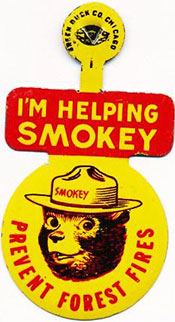
Metal Fold-over badge.
Chances are most N.O.W. News readers recognize this message about the dangers that forest fires pose. Readers also likely know the advertising icon that has made this saying famous. In fact, surveys tell us that as many as 95% of adults and 77% of children recognize Smokey Bear, and three out of four adults even recall his message without prompting. Not surprisingly, the popularity of Smokey Bear has led to a multitude of promotional items, including tokens and medals, that have helped spread his fire prevention message. Here, I briefly recap Smokey Bear’s 70-year history and highlight some items that may be of interest to the numismatist.
Introducing Smokey Bear
Between the 1850s and 1910 large catastrophic fires, fueled by slash left from intensive logging, raged across much of the Upper Midwest. Major fires in Wisconsin during this period included the Peshtigo Fire (1871), recognized as the deadliest fire in the nation’s history having taken between 1,200 and 1,500 lives and having burned more than 1.5 million acres. The Comstock Fire (1891) destroyed 64,000 acres, including the entire village of Barronnett. The Phillips Fire (1894) consumed over 100,000 acres, destroyed over 400 homes, and claimed 13 lives. Similar fires swept throughout the Great Plains and blazed in the Rocky Mountains and Pacific Northwest.
Such horrendous events led to fire prevention and suppression efforts. As early as 1902, the U.S. General Land Office distributed a fire prevention poster. Wisconsin appointed its first town fire wardens in 1905, the same year that Congress established the U.S. Forest Service. Six years later, the state hired its first forest rangers. Construction of ranger stations and fire lookout towers followed. These early efforts, however, were largely understaffed and suffered from a lack of adequate equipment. Demands for more adequate fire protection grew and the Forest Service adopted a policy of “all fires out by 10:00 a.m.” during the Dust Bowl Era. Human causes of fires began to receive greater attention around this time. A poster distributed in 1939 featured an Uncle Sam-like forest ranger pointing at a raging forest fire with a “Your Forests-Your Fault-Your Loss” caption. It wasn’t until World War II, however, that nationwide fire prevention efforts really got underway.
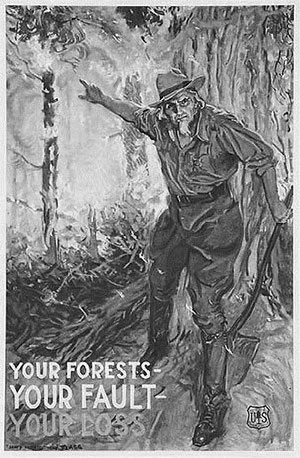
1939 U.S. Forest Service
ad campaign
Early in 1942, a Japanese submarine surfaced off the coast of California. Shells fired from the sub exploded near the Los Padres National Forest raising concerns that bombardments in Pacific Coast timber stands could easily set off raging forest fires. Protection of the forests suddenly garnered national attention and the Forest Service initiated the Cooperative Forest Fire Prevention Program.
In 1944, Walt Disney authorized the fledgling program to use the title character from his recent motion picture “Bambi” on a fire prevention poster. This poster demonstrated that an animal could be used successfully as a fire prevention symbol, but a single-year agreement limited Bambi’s appearance. Working with the Wartime Advertising Council, the Forest Service adopted a bear as the program’s mascot. In late 1944, commercial illustrator Albert Staehle painted the program’s first poster depicting a bear extinguishing a campfire with a bucket of water. Named after “Smokey” Joe Martin, an assistant chief with New York City’s fire department, Smokey Bear debuted in the program’s 1945 ad campaign with the slogan “Smokey says – Care will prevent nine out of ten forest fires.” Jackson Weaver, a noted personality from WMAL radio in Washington, DC, provided the original ‘voice’ of Smokey. Smokey’s slogan was modified in 1947 by the Ad Council to “Remember... Only YOU can prevent forest fires.”
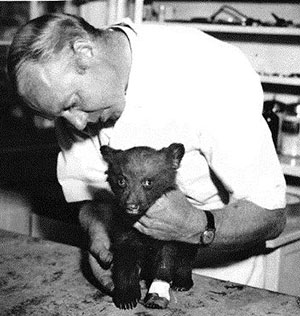
Dr. Edwin J. Smith provided
veterinary care for the bear cub.
(U.S. Forest Service)
In the spring of 1950, firefighters rescued a black bear cub from a wildfire in the Capitan Mountains of New Mexico. The lone cub had taken refuge in a tree, and while its climb had saved its life, the bear was burned badly. The cub received veterinary care and was nursed back to health. Later, the State Game Warden presented it to the Forest Service to be used as a symbol of fire prevention and wildlife conservation. Amidst considerabl emedia attention, the cub was moved to the National Zoo as a “gift to the school children of America” and became the living symbol of Smokey Bear.
In the early 1950s, Wass & Son of Philadelphia, one of the top costume companies in the eastern United States, produced the first Smokey Bear costume for the Virginia Division of Forestry. The initial costume’s popularity led to the production of additional costumes and Smokey Bear became a familiar guest in small town parades and at community events. His first appearance in Wisconsin is believed to have been at a Fireman’s Convention Parade in Hurley.
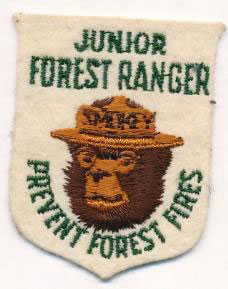
Songwriters Steve Nelson and Jack Rollins released “Smokey the Bear” in 1952, giving Smokey a ‘middle name’ to maintain their song’s rhythm. The 1955 “Little Golden Book” titled Smokey the Bear followed, and this variant of his name soon became widespread.
Smokey Bear easily “won the open admiration of millions of youngsters.” The Forest Service launched a Junior Forest Ranger program in 1952 and encouraged children to write him detailing their interest in fire prevention. In reply, writers would receive a Junior Forest Ranger Kit. By 1965, the large volume of incoming mail pushed the U.S. Postal Service to give Smokey his own Zip Code: 20252.
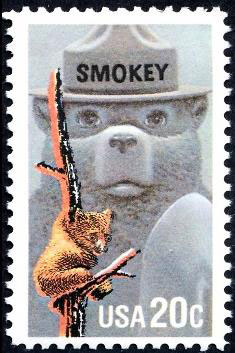
The living Smokey Bear died in 1976. In anticipation of his death, the U.S. Congress discussed and debated funeral arrangements for the aging bear and ultimately passed a resolution to ensure “proper disposition and a permanent memorial.” The New Mexico Legislature provided funds to “honor one of its most famed citizens,” and Smokey was buried under a stone marker in a new state historical park near the small town of Capitan.
The use of Smokey Bear has evolved continuously in response to changes in mass media and increased competition for the public’s attention. In 1984, Smokey appeared on a first-class postage stamp. In 1987, the Forest Service launched “Smokey Sports,” and “National Smokey Bear Day” occurred in conjunction with all Major League Baseball games throughout the U.S. and Canada. In 2001, Smokey’s message was updated to “Only YOU can prevent wildfires!” in response to fires in natural areas other than forests. In 2004, the Forest Service celebrated with a special “60 Years of Vigilance” logo. That same year, the program again enlisted the help of Bambi, featuring the character on posters and in public service announcements.
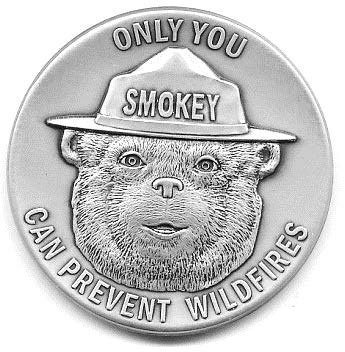 |
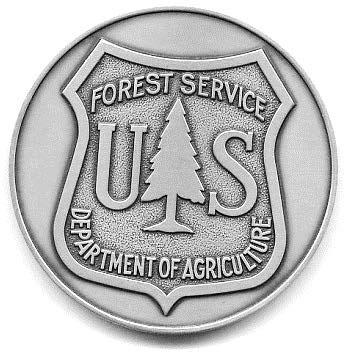 |
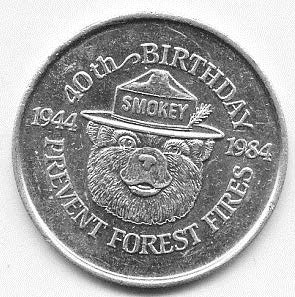 |
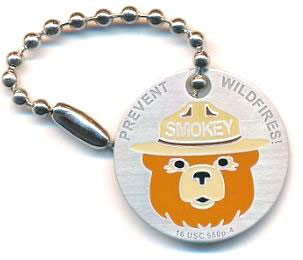 |
| Northwest Territorial Mint produced this 39-mm bronze “challenge coin” for the U.S. Forest Service. | The U.S. Forest Service issued this aluminum promotional medal for Smokey’s 40th birthday | Geo-caching tags have become popular in recent years. | |
Today, the Forest Service, National Association of State Foresters, and Ad Council jointly administer the Smokey Bear brand. Federal law protects Smokey Bear’s name and image, with commercial licensing fees and royalties used to promote forest fire prevention. Hundreds of items have been licensed under this authority.
While we now understand that fire plays a role in the health of some ecosystems, wildfire prevention remains an important concern. Almost 65,000 wildfires result from human carelessness nationwide each year. Recently, here in Wisconsin, the Cottonville Fire (2005) burned 3,410 acres and destroyed 90 buildings. Containing the fire required almost 200 firefighters. The Germann Road Fire (2013) in Douglas County, consumed 7,442 acres and destroyed 47 structures, scorching a swath nearly 10 miles long and 1.5 miles wide before being contained.
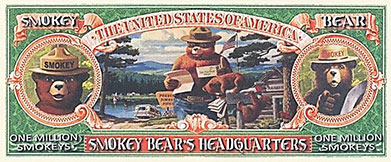
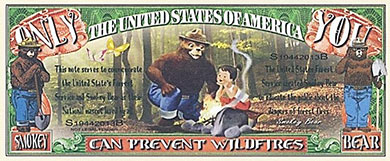
Paper money enthusiasts might enjoy this privately issued fantasy note from 2013.
Conclusion
Children still need to hear and learn about the affable bear in ranger hat and blue jeans. Adults also need continuous reminders about the importance of wildfire prevention. Ongoing concern will likely result in even more collectible Smokey Bear items giving numismatists and others the opportunity to assemble interesting and unique collections for years to come.
References
“An obituary for Smokey Bear” by Jim Moore. Winslow Mail (November 11, 1976, p. 11).
dnr.wi.gov/topic/ForestFire/WisconsinFires.html
“Funeral arrangements for Smokey the Bear.” New York Times (August 6, 1974, p. 34).
Guardian of the Forest: A History of the Smokey Bear Program by Ellen Earnhardt Morrison. New York: Vantage Press. (1976). 129 pp.
“New Mexico honors Smokey.” Los Angeles Times (May 12, 1975, p. B17).
Smokey Bear Act, Public Law 82-359 (1952) and amendment Public Law 93-318 (1974). (16 U.S.C. 580; 18 U.S.C. 711). smokeybearassociation.com
“Smokey Bear enlists billikins for help.” The Chicago Defender (October 3, 1953, p. 8)
Smokey Bear Guidelines. Washington, DC: U.S. Forest Service Cooperative Fire Prevention Program, The Advertising Council, Inc., and National Association of State Foresters. (2011).
“Smokey Bear’s 40th birthday: Make Smokey’s birthday wish come true.” The Hobbs Flare (August 16, 1984, p. 4).
“Smokey the Bear gets letters at rate of about 1,000 a day.” Roswell Daily Record (August 19, 1955, p. 6).
www.adcouncil.org/Our-Campaigns/The-Classics/Wildfire-Prevention
Have an interesting numismatic topic you’d like to share with your fellow NOW members?
Send your article to evan.pretzer@protonmail.com today!!!